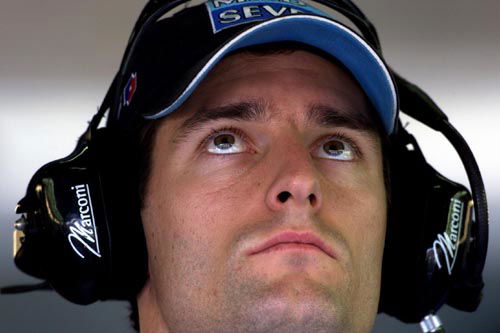Lauda turns back the clock with Jaguar test.
After an absence of 16 years, three-time Formula One world champion and Jaguar Racing team principal Niki Lauda made a historic return to the cockpit at Valencia today [Sunday].
The Austrian, who assumed control of the Jaguar team on the departure of American Bobby Rahal, got behind the wheel of last year's R2 at the Ricardo Tormo circuit in eastern Spain, and took the car to its limits, spinning twice..
After an absence of 16 years, three-time Formula One world champion and Jaguar Racing team principal Niki Lauda made a historic return to the cockpit at Valencia today [Sunday].
The Austrian, who assumed control of the Jaguar team on the departure of American Bobby Rahal, got behind the wheel of last year's R2 at the Ricardo Tormo circuit in eastern Spain, and took the car to its limits, spinning twice..
The 51-year old legend completed ten laps of the four kilometre track with the intention of discovering for himself the characteristics of a modern Formula One car, to help him understand the technology that today's F1 drivers have at their finger-tips.
"It was very interesting for me to experience today the technical advances that have taken place in the last 16 years, and how they make a modern Formula One car so different from what it was like when I was racing," Lauda said afterwards.
"My intention was to learn as much about the electronic systems on the car as possible, so that I can relate directly to the drivers' experiences when they are describing technical computer-related issues. Today, I have finally discovered what they experience and how I can better assist them in my capacity as team boss."
Despite not having sat in a Formula One cockpit for over a decade, Lauda showed himself to have lost none of his characteristic speed in a car. With a 50kg fuel load on board, his straight-line speed was the same as that of Jaguar Racing's driver Pedro de la Rosa and the entry into two of the circuit's corners was identical to the Spaniard's, despite spinning at the same bend on consecutive laps.
"I span because I was braking where Pedro had told me to brake!" Lauda joked, "But I was pleased that I went into the corner at the same speed as him until it spun. I would much rather have spun today than be accused by Pedro and Eddie of having tip-toed around the circuit."
Although Lauda noted a difference in tyre grip levels compared to the 'slick' tyres he used throughout his career, it was the effect of the electronic driver aids that stunned him the most.
"Today, with the paddle-shift gear levers, you can keep both hands on the wheel all the time around the circuit - when accelerating, braking, even from a standing start," he said, "The gearbox and clutch combination is most impressive. It allows you to complete smooth up-shifts from one gear to the next at over 16,000rpm without a jolt. And when changing down, the engine management software adjusts the throttle opening to match road speed and engine speed, again with very smooth results.
"All this electronic technology, of course, makes today's car very different to when I raced. Back then, at the start of a race, you had to judge the precise point at which to feed in the clutch and adjust the engine revs to achieve a good start. Today, you press the button for 'launch control' and the engine revs are held at full throttle. You then just let the clutch in - bang! Via the software, the engine then knows that the wheels should not spin and you make a perfect start - every time."
With the electronic traction control able to help limit excessive wheel-spin through and out of the corners, Lauda found the Jaguar R2's handling to be more progressive than the F1 cars he was used to.
"Admittedly today cold tyres did not help but I would say overall grip levels are lower than with the full slicks I remember. This is due to grooved tyres and less aerodynamic pressure on a modern F1 car," he recalled.
"Then, you had very high grip up to a certain point beyond which it would just let go! Today, I was experiencing understeer going into the corner and twitchy oversteer on exit. Although this was due to the track conditions, I would think you would have to drive this car consistently at a very high level to get the maximum out of it, which is tricky due to this low grip/high grip transition.
"When I raced, it was left to the driver to fully control the car. These electronic advances in Formula One now make the sport the technology leader in the auto industry. After all, traction control technology and other computer-driven systems, in different forms, are now available on many road cars, including Jaguars."
Based on today's reunion with a Formula One car, Lauda will now build on this experience as he oversees Jaguar Racing's development of the new R3 and its progress through the coming season. But he has no plans to join Eddie Irvine or Pedro de la Rosa full-time.
"I did no physical preparation for this test - apart from reduce smoking!" he joked.
Jaguar's pre-season schedule continues at Valencia this week.
